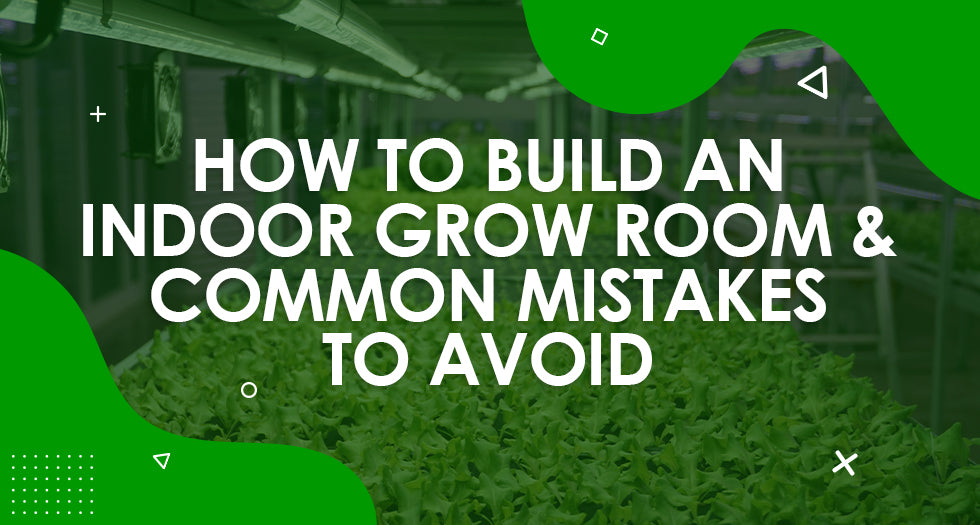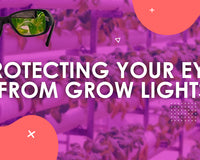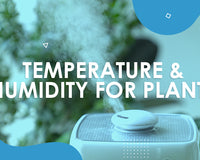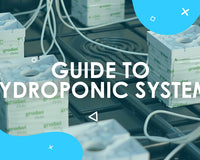If you’re wondering how to build an indoor grow room and what common mistakes to avoid, read on for some top tips. Done right, a grow room can provide the perfect space to nurture your plants in a controlled environment. However, many first-time growers can make mistakes that can be costly, ruin plant health and affect yield. Taking care when setting up equipment and caring for your plants is vital for success.
A successful growing environment will be designed to provide optimal conditions for plant growth including light, ventilation, temperature and humidity.
There’s something to be said about growing your own produce at home. As well as having the satisfaction of growing your own crops, you can become less reliant on shop bought produce and enhance your personal food security. This article covers how to set up your grow space including all the equipment you’ll need, and mistakes to avoid along the way!
Where to locate your indoor grow space?
There are a few golden rules to follow when deciding where to locate your grow space. It needs to be:
- Near an electricity supply
- Close to a water source (filtered water is best)
- Big enough for the number of plants you want to grow
- Clean, dry, secure and easy to access
A small space can limit your yield and make it harder to maintain optimal conditions. If you’re building your very first grow room, it’s probably a good idea to start out small then expand out when you are more experienced as you’ll learn a lot when starting out!
How much space will you need?
Before you start shopping around for your equipment, it is essential to ensure you have enough space to accommodate your new growing room. Planning how many plants you want to grow in advance will help you determine the amount of space needed.
A mistake first-time growers often make is underestimating the amount of space they will need, only to find out later on that they need to expand their growing environment. A good rule of thumb is to allocate at least 1 square foot per plant, plus some extra space for ventilation and movement.

BudBox PRO XL plus-HL 150x150x220cm
|
Electrical safety
When it comes to electricity, you must ensure safety is observed at all times. This means ensuring that you don’t overload the circuit and use appropriate surge protectors to protect equipment and prevent electrical and fire hazards.
A common mistake beginners can make is overloading plug adapters, like 4-way adapters. This type of plug is only designed to handle a certain amount of current from the devices that are plugged into it. If the total current exceeds the maximum limit, the plug could overheat, create a fire hazard or damage your electrical equipment. We advise that you check the ratings of the equipment and plugs before using them together.

LUMii BLACK Contactor
|

LUMii Socket Contactor
|

Hero 8 Way Contactor + Heater
|
Noise
You’ll also need to factor in noise. Some growing equipment like fans can be noisy, so make sure any noise produced will not be an issue before you start your build. The last thing you need is to put time and effort into a build only to find out you have to relocate it due to excess noise.
Of course, there are products available that take noise into account, such as silent fans. These are great if you cannot avoid growing in a space where noise doesn’t matter.

Rhino EC Ultra Silent Fan
|

RAM SONODUCT Ducting
|

Can-Fan Isomax Silenced Fan
|
Grow Tent, Cupboard or Room?
Places to locate your grow space can include anything from a grow tent to a disused cupboard or a dedicated room that you can make light-tight to block out all external lighting.
Taking time to consider the pros and cons of each type of grow environment is important. For example, you don’t want to commit to using a room that is much too big for a relatively small crop. Likewise, you don’t want to invest in a grow tent and all the equipment only to discover your chosen tent is much too small.
Flooring is something to consider as well. For cupboards or rooms, make sure you have a suitable easy to clean hard floor. Carpet is not ideal as it is absorbent making it much more difficult to clean up spills.
Grow tents usually have removable tray floors to make them easy to clean after accidental spillages. If you’re using a room to grow and your flooring is not ideal, then you can use special floor coverings like the EasyGrow Floor Secure which have been specially designed to protect floors from water damage.
Let’s take a quick look at the different grow room options.
Grow Tents
Grow tents are specially designed fabric enclosures that create a sealed and insulated environment for your plants. They come in various shapes and sizes and usually feature ventilation ports, windows, reflective walls and hanging bars. Highly regarded brands include Budbox tents which
come in both budget and premium models to suit your needs.
A grow tent is a brilliant option if you’re just starting out and they can help you to control temperature, humidity and light. They are also pretty good at helping to control the odour of your grow room, a great advantage if you are growing strong smelling plants.

BudBox LITE 80x80x160cm
|

BudBox PRO TITAN 1-HL 200x200x220cm
|
A Spare Room
If you have a spare room, this offers a simple and cost-effective option as long as it meets the requirements for size, power, water, noise, flooring and light. A dedicated room also offers the potential to expand your grow space in the future if required.
The room will need to be made light tight – insulated from external light sources (and to ensure no light escapes). To do this, you’ll need to cover windows and walls with reflective sheeting. To enhance reflectivity in the room, it is a good idea to either paint the walls with reflective paint or use reflective coverings over the wall space. Doing this will ensure that light gets reflected off the walls back onto the plants. You’ll also need to install an exhaust fan and an intake vent on opposite sides of the room to create airflow.

Lighthouse ULTRALUX Flat Black White
|

EasyGrow Floor Secure 25x4m
|

Rhino EC Ultra Complete Extraction Kit
|
A cupboard
Growing in a cupboard could limit how many plants you can grow, depending on its size. It is also one of the cheapest options but better suited if you only want to grow a small number of plants.
You can use an existing cupboard or build one yourself using suitable materials – just ensure they are water and heat resistant for safety. Like any other grow space, you’ll need to cover the interior with reflective sheeting or paint. Make sure to cut holes for ventilation and wiring.
Growing Method
Do you want a pure indoor hydroponics set up or would you prefer to grow plants in containers with soil or coco coir? If you choose to grow using hydroponics, you’ll need to decide which type of method you want to use first.
Hydroponic systems include drip, ebb and flow, wicking, nutrient film technique (NFT), aeroponics, and deep-water culture (DWC) systems.

Danish Hydro Tray
|

Autopot Easy2Grow
|

Idrolab DWC Solo 35L (Complete Kit)
|
We recommend doing thorough research into the grow method you intend to use before you start buying the kit. If you can, speak to fellow growers to find out their experience with different grow methods. Real-life advice can be a valuable resource and help you avoid mistakes that others have made before you.
You can read more about each type of hydroponics system here.
What equipment do I need for a grow room?
It’s a good idea to take note of the equipment you’ll need to be able to set up a successful indoor grow room before you get started. This will ensure that you can plan for all the required equipment in advance and have the time to research products that fit within your budget.
The following list details the essential kit you’ll need:
- Suitable cupboard, grow tent or light-tight room
- Indoor grow lights
- Reflectors
- Light hangers
- Reflective sheeting/paint
- Table, bench or racking
- Containers (plant pots or fabric containers)
- Grow media
- Irrigation system or watering can
- Reservoir tank
- Nutrients
- Grow media
- Ventilation ducting (for larger grow rooms)
- Extractor fan
- Intake fan
- Oscillating fan
- Carbon filter
- Humidifier
- Dehumidifier
- CO2
- Timers
- PH meter
- Seeds or seedlings
- Spray bottle for misting
- Electrical conductivity reader
- Eye protection
How to set up your grow room
Once you have all your equipment ready and you have decided on where you will locate your grow space, you’re ready to start building your grow room!
Install your lighting
Lighting is an essential aspect to ensure optimum plant growth and development. There are many different types of grow lights to choose from including LED, HPS, CDM or CFL. Each type has its own pros and cons.
- LED: Light Emitting Diode grow lights are energy-efficient, long-lasting and customisable. They can produce a full spectrum of light that can be tailored to the specific needs of different plants. However, they are also expensive, require cooling systems and may not penetrate deeply into the plant canopy.
- HPS grow lights: High Pressure Sodium lights are powerful and can provide intense light that can boost flowering and fruiting. However, they are also energy-hungry, heat-generating and have a limited spectrum of light that may not suit all plants.
- CDM lights: Ceramic discharge Metal-halide grow lights are a newer technology that combines the benefits of metal-halide and high-pressure sodium lamps. They can produce a balanced spectrum of light that can support both vegetative and flowering stages. However, they are also expensive and may degrade over time.
- CFL lights: Compact Fluorescent Lamps are relatively cheap, easy to use and are suitable for small spaces. They produce a moderate amount of light that will support seedlings and clones. The downside is that they can be inefficient, dim over time and have a short life-span.

Maxibright Daylight LED
|

Photon LED Board
|

LUMii BLACK 600W Digital Kit
|
When deciding on what lights to invest in, it’s a wise idea to speak to any growers you know or reputable suppliers for advice. This is because not every set up is exactly the same.
Plants require different ratios of blue and red light depending on the growth cycle and the light spectrum can ultimately affect growth, flowering, flavour and yield. At London Grow, we are happy to recommend grow lights to our customers depending on their particular needs. If you need any help, just get in touch.
Another important factor to consider with your lighting rig to ensure a successful indoor crop, is the distance between the grow lights and the plants. Many beginners make the mistake of mounting the lights too close which can burn or stress the plants. Likewise, mounting lights too far away can affect growth due to reduction in light intensity and coverage.
The optimal distance to mount your lights depends on several factors including the type of light, size, wattage, plant growth phase, temperature and humidity of the grow room. Generally, lights should be at least 12 inches away from the top of the plants. You’ll need to remember to adjust the lights as the plants grow.
Most light hangers are adjustable, like the LUMii Rope Ratchet Hangers. The simple pulley system allows you to raise and lower your lighting. They can also be used for mounting reflectors.
Ventilation
Ventilation for optimal air exchange is vital for plant health. A continuous source of free moving fresh air along with efficient extraction of stale air, excess heat and humidity will promote healthy plant growth. A good ventilation system will also help to prevent mould and pests.
Failing to install a decent ventilation system can lead to a whole host of problems such as:
- Low CO2 levels – this can directly impact photosynthesis and growth.
- High temperature – if the temperature is too high it can stress plants, reduce photosynthesis and increase the risk of pests and diseases.
- High humidity – excess humidity can encourage mould growth, pest invasions and disease.
- Stale air – stagnant air can lack in oxygen which is essential for plants to respire and turn glucose into energy.
- Odour – poor ventilation will enhance odour.
Your ventilation system will consist of an intake fan and extractor fan, and depending on the size of your grow room, you may need ventilation ducting. You will also need circulation fans to maintain air movement with the grow space.
Grow tents come with readymade ventilation ports. If you’re using a cupboard, make sure you cut holes to the right size for your ventilation equipment.

Systemair Revolution Vector EC Fan
|

Phresh Fan HyperFan
|

RAM Carbon Filter
|
Carbon filters are a good idea as well, because they clean the air and remove odour – an essential accessory if you’re growing pungent crops. They attach to the extraction system so air can be cleaned before it is extracted from the grow room.
Noise can pose an issue with ventilation systems. If you need to keep noise levels to a minimum, silent fans like the Rhino EC Ultra Silent Fan offer excellent noise reduction, performance and energy efficiency.
Grow Trays, Containers, Tables & Benches
Many complete irrigation systems come with custom pots or containers that integrate seamlessly with the system. However, if you are building our own custom setup then you should choose containers and trays that are big enough for your needs. Ideally, the size and shape of your containers should match the size and growth pattern of your plants.
Don’t forget to invest in a grow table. You can buy specialist grow tables and rolling benches or if you are just starting out you can use a standard table or potting bench, just make sure it is waterproof, big enough, sturdy and weight bearing.
The type of table you need for a grow room will depend on various aspects such as the type and size of the plants you wish to grow, the number of pots, the lighting system and ventilation. You’ll also need to consider how much space you need between your structures to ensure optimal airflow and light distribution for your plants.
Common options include metal racks and wooden benches, and some growers use mounted PVC pipes.
Irrigation System & Nutrients
Healthy, fruitful plants need the correct levels of water and nutrients to thrive. The right amount of water is crucial for health, growth, and quality of crop, so it’s important to ensure your plants are watered at the right time and at the correct intervals.
Nutrients are mixed into the water and are delivered to the plants from the reservoir. The type of reservoir you use will vary depending on your growing method.
There are many different types of plant nutrient solutions and some can even help combat pest invasions. The type of nutrients you need will depend on the plants you want to grow, so it’s a good idea to do some research before you buy anything.
One of the most common mistakes beginners make when starting out growing is giving their plants too much or too little water and nutrients, so educating yourself on how to mix plant nutrients first is a good idea.

Advanced Nutrients Complete Kit for Soil
|

Biogreen Nutrients Complete Kit for Coco/Hydro
|

Dutch Pro Nutrients Kit for Soil
|
Over watering can cause root rot, oxygen deficiency, and fungal infections while too little will cause dehydration. Excess nutrients can cause nutrient burn, nutrient lockout, salt build-up and other problems while too little can stunt growth. Investing in an EC meter will allow you to measure the nutrient concentration in your water.
Different hydroponics systems will vary in the way nutrients are delivered to the plants. For example, deep water culture systems are different to nutrient film technique systems but generally each system involves a reservoir and pump to deliver nutrients into the root zone. For further information on the different types of setups and equipment see our hydro systems page.
If you are growing in containers with hydro, soil or coco coir, a drip irrigation system is easy to use and automate. However, if you’re on a budget and are only growing a small number of crops you could hand water, but this can be very time consuming and requires a lot of commitment. If you are hand watering, you’ll need to mix your nutrients up and use a watering can to feed your plants.
Drip systems are popular as they are suitable for both beginners and professionals. They can be used with pure hydro, soil, coco and other grow media. Origin manufactures easy to use automatic drip systems that are quick and simple to set up. These systems come with everything you need including jet pump and filter.
Another popular option is Autopot irrigation systems. These work by delivering nutrients to containers via a network of tubes connected to a large header reservoir tank. These systems require no electricity and are easy to set up. They automatically feed your plants, saving you time and
hassle.
Grow Media
If you are a beginner then it’s a good idea to trial a few different types of growing media. Popular grow media includes coco coir, clay pebbles, and good old fashioned high-quality potting soil. Our article on the best grow media can help you decide which substrate might suit your needs best.
Rockwool is another media that is popular for growing seedlings due to its excellent water to air retention balance to ensure your seedlings and cuttings have optimal nutrient uptake.

Biobizz Light Mix
|

Substra Coco Brick 10L
|

CANNA Coco Pebble Mix 50L
|
Coco coir is great for high yields with quick harvesting and it also minimises the risk of pests.
Clay pebbles have water retaining qualities to ensure your plants stay hydrated. They’re also long lasting and eco-friendly and can make it harder for pests like aphids and thrips to navigate up from the root zone, reducing the risk of an invasion.
Soil is often preferred by beginners and it is a common grow medium for professionals too. There are many types of good quality soils available to buy that are already optimised with the correct balance of fertiliser and pH, so you won’t need to worry about testing your soil.
Start Growing!
Once your grow room is set up, you can move on the best part – growing your own crops! Whether you are starting out from seeds, seedlings or cuttings, careful management of conditions in the grow environment is essential to ensure success. Regularly checking of temperature, humidity, light and pH is advised.
You’ll also need to perform regular inspections for pests and prune your plants. Pruning will help to control the size and shape of your plants and increase airflow and light penetration, helping improve overall health and yield. Pruning will also remove dead or diseased parts which can attract pests or encourage disease.
At London Grow, we supply everything you need to build an indoor grow room and are happy to share our knowledgeable advice. So, get in touch if you need any help or read our grow tips blog for further advice.

SHOP NOW READ MORE






